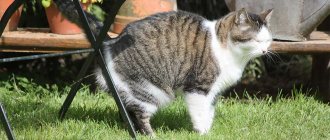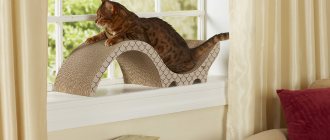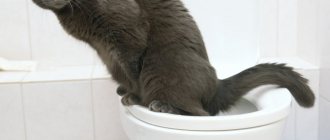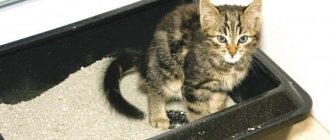Owners of one-year-old cats are faced with an unpleasant problem: the pets begin to mark their territory. Puddles in the wrong place, marks on furniture, clothes and wallpaper, a terrible smell hanging in the apartment - all this terrifies the owners. Will this nightmare really last forever? Neither punishment, nor screaming, nor attempts to eliminate the smell produce positive results. Cats mark territory, because this is inherent in them by nature. To wean a cat from marking, you can use the services of a veterinarian and castrate the animal, but there are other, less drastic methods.
The nature of the appearance of marks
It is necessary to distinguish between marks left by a sexually mature animal and the uncleanliness of a kitten. If a pet, since childhood, does not go to the litter box, but to its favorite corner, this is a real example of uncleanliness. In the event that a cat diligently went to the litter box until 8-9 months, and then suddenly began to “shit”, these are clear signs that hormones have played out in it, and the pet is marking its territory.
The chemical composition of the liquid sprayed during territory marking differs from urine. It includes hormones, pheromones, seminal fluid. This pungent odor is almost impossible to remove. The apartment begins to smell terribly. Nature arranges it in such a way that males mark their territory. These markings are clear to other animals. If there are many males in a cat pack, the most important of them puts the marks.
To prove that a domestic kitten is not the most important among the members of the new family, you will have to work hard with it. Proper parenting works wonders, so the main aspects should be considered.
Who is the head in this house
Clarifying the relationship between a cat and a person can give positive results. The pet does not react to a scream, and if you poke its face into a puddle, it may hate it with all its heart. You need to speak cat language:
- Having caught the mustachioed Casanova in the act, you need to carefully grab him by the scruff of the neck. Cats don’t like this, they tuck their paws and tail, realizing that some kind of punishment will follow;
- Look carefully into your pet's eyes and begin to hiss threateningly. This must be done with a serious and menacing look, otherwise the animal will not react as desired;
- remembering how street cats fight, lightly (without fanaticism), hitting your own miscreant in the face. At the same time, do not look away, waiting until the pet begins to meow pitifully and looks away;
- demonstration lesson on the topic “Who is the boss in the house” was successfully completed. The cat understands that a leader has appeared on the territory and stops putting his own marks.
To consolidate the result, you need to wash off all the old marks and apply strong aromas of perfume, cologne, shoe spray, etc. over them.
This will achieve two goals: the cat will understand that the marks were placed by the leader, and on the other hand, the strong smell is unpleasant to the animal, and it will not approach the fragrant corners for a long time.
Inconvenient toilet
Sometimes the cat doesn't like where his litter box is. Even an animal needs privacy while defecating. If, in the animal’s opinion, the tray is located inconveniently, the pet begins to mark the corners out of spite. With this behavior he tries to attract the attention of the owner. Toilet whims can be caused by the following factors:
- Odor or excrement in the litter box. Not all pets agree to go to the dirty toilet several times. Some demonstratively begin to mark corners, drawing the owner’s attention to the dirty tray.
- Small tray. The dimensions of the box must match the size of the pet. If he experiences inconvenience when defecating in the tray, puddles begin to appear in the wrong places. These marks are a signal to the owner that the cat is dissatisfied with the existing tray.
- Some animals do not like litter or a particular type of litter, while others, on the contrary, do not want to go on a grid without litter. Each cat needs its own approach. If the marks appeared after purchasing a new filler, you need to return to the old version. If your pet does not want to go into an empty litter box, you should purchase litter in advance to avoid the hassle of an empty bag and puddles on the mat.
More reasons why a cat marks territory
In addition to the main and common reasons, there are many prerequisites for a cat to start marking your home:
- Moving. Instinctively, a cat explores and marks a previously unknown territory as a cat, thus protecting it from the encroachments of other animals. In such a situation, it is worth being patient. Over time, she will calm down and the desire to mark will disappear.
- Other cats leave marks on the front door. The problem often arises among owners of private houses. Foreign odors cause stress for your pet, prompting you to mark the furniture.
- Crowded housing of a large number of animals in a cramped room. Cats are by nature territorial creatures: just as street fighters take their places in the hierarchy, so a pet will strive to win a place in the sun by marking the boundaries of its territory. The more living creatures per square meter of an apartment, the higher the likelihood of marks occurring.
- Physical violence - when a cat is squeezed against its will, or, even worse, harsh methods of punishment are used for misdeeds. She is under constant stress, which prompts her to mark for self-soothing purposes. Owners are advised to reconsider their attitude and parenting methods.
- Excessive spoiling of a pet is the other side of violence, when the cat’s misdeeds get away with it. Over time, the owners realize that it is time to start raising their pet. Punishment or refusal to do something, such as giving food from the table, can cause protest. She begins to aim to harm her owners.
Choosing a tray and a place for it
There are several types of cat litter:
- An open box with sides is suitable for any type of filler. The higher the sides, the less filler there will be on the floor. Some pets like to intensively cover their tracks; in this case, it is advisable to purchase a design with high sides curved inward. No matter how hard the cat tries, the granules will not scatter across the floor.
- A box with a grid that can be used without filling or with a small amount of absorbent granules.
- A toilet in the form of a house, into which expensive filler (silica gel) must be poured.
It is important to choose the right location for the tray.
Cats are very sensitive to the process of defecation and want to do it in a secluded place. In addition, access to the toilet must be free, that is, the door must always be open. Placing a pot in the kitchen is unhygienic. Pets don't want to go to the toilet next to their food bowl. And for people, cat litter in the kitchen is an unpleasant sight.
The bathroom is also not very comfortable. For example, one of the family members decided to take a swim, but the cat wanted to go to the toilet. He won’t wait long; he’ll go check in somewhere in the hallway or under the sofa. It is best to place the tray in the toilet. To prevent the filler stuck to the pet’s paws from spreading throughout the rooms, a rug is placed underneath.
The quality and smell of the litter can also cause hostility in the cat. There are several types of fillers, each of which has its own advantages:
- absorbent sawdust granules are the cheapest option. The disadvantages are that they need to be changed frequently; spilled granules stick to the paws and tail, so they spread throughout the rooms;
- bentonite filler - also has several varieties: small, large, medium, with herbal aroma and odorless. The price of the litter is average, the disadvantages are the pet’s paws being smeared and white marks on the floor of the toilet;
- silica gel is the most convenient, but also quite expensive type of filler. It perfectly absorbs odor, does not smear the pet’s paws and holds urine well. It is poured in a layer of 3-5 cm and changed if the granules have changed their color. This type of filler is suitable for any type of tray.
There is another option, the most optimal for everyone: to teach the cat to go to the common toilet. For this purpose, special toilet pads are available for sale. The advantages are as follows:
- no tray needed;
- no need to buy filler;
- There is no need to clean the tray.
This all saves owners money and time. But not all animals can be toilet trained. There are stubborn animals that do not want to relieve themselves in a common toilet.
Among the disadvantages of sharing a toilet, it can be noted that in a large family in the morning there is not enough time for everyone, and then there is the cat doing his business.
Outputting marks
The cat is attracted to his own marks on wallpaper, furniture and other things. To discourage him from these marks, it is necessary to eliminate the smell. You can wash the area with a disinfectant, and then place orange or lemon peels in this corner, or sprinkle ground black, red, or allspice. Vinegar does not eliminate the odor, but, on the contrary, enhances it, so it is not advisable to wash marks with water and vinegar.
The pet store recommends purchasing a repellent spray. This product is sprayed on the places that the pet has chosen for marks. There is another aerosol - to attract animals. Its purpose is to teach the cat to go to the toilet. Therefore, when purchasing, it is important not to confuse the names of the sprays.
Another trick to scare a cat away from corners: stick double-sided tape on the floor around your pet’s favorite places to visit. Sticky areas frighten the animal, and it tries not to approach them.
Food and toilet for a pet are incompatible concepts. You can use one more trick. A bowl of food should be placed in the unfortunate corner with the marks. The pet won’t even think about shitting there anymore, because food is much more important than any principles.
How to stop cats from marking doors, walls or corners: consolidating what has been achieved
Demonstrating your dominance to an animal is not enough. You will also need to thoroughly wash the marks left by your pet, for which you will need to resort to the use of special compounds sold in pet stores. In addition, you will have to leave your own scent in these areas. For such purposes it is necessary to use socks and other items of clothing. Another option is to spray with perfume or cologne that the owner constantly uses. Such methods usually lead to the absence of relapses, but they are useless for those who are faced with the problem of how to wean a cat from marking its territory on the street or in the entrance. If the source of trouble is foreign or stray animals, other measures will be required.
Castration
The most difficult decision is to castrate your pet. If no tricks and tricks help, the pet continues to mark in the wrong places, while going to the toilet in the tray intended for this, then the problem is in hormones and sexual desire. Castration will help eliminate the natural craving for marks.
For many families, this is a painful issue, but it needs to be resolved.
Castration should not be delayed. The optimal age for surgery is 7-10 months.
If your pet is already hanging out with cats, even after neutering he will mark for some time. You need to be prepared for this.
For those who doubt whether surgery is necessary, it is recommended that you familiarize yourself with the following information:
- During castration, the gonads are removed, which helps suppress the cat's sexual desire. If this is done before the first sexual intercourse (before the age of 1 year), he will no longer mark the territory.
- After castration, the cat stops meowing mournfully, which allows not only family members, but also all neighbors to get some sleep.
- The cat stops showing aggression, does not get into fights with yard animals, which is also important, because after a fight, pets come with torn ears, black eyes, infectious skin diseases begin, lichen appears, etc.
- Many people are afraid that a neutered pet will become obese and lie lethargically on the sofa. This will happen if you don’t reconsider his diet and physical activity. There are special foods for neutered cats that prevent severe weight gain. If the pet eats only natural products, the daily amount of food is reduced by 10-20%, but the load is increased. Outdoor games, running after a ball or a candy wrapper tied on a string will not allow your pet to relax and eat off its sides.
- Pets are difficult to tolerate anesthesia. The answer to this statement is that if the pet is properly prepared for surgery, then the consequences will be minimal. The doctor will tell you how many hours before the operation the cat should not eat, and what manipulations the owner will have to perform after the cat’s operation. Animals usually recover from anesthesia within 2-3 hours, but there is no need to worry if this process takes a little longer. If the animal does not feel better 5 hours after the intervention, you must call a veterinarian.
If the owner takes a long time to decide whether to have surgery or not, time may be lost. Castration of adults does not provide a guaranteed result. The pituitary gland is also responsible for the production of sex hormones in cats, so an adult cat remembers all his love affairs and will not quickly give up on them.
Is it all because of heat?
Upon reaching the age of 6 - 8 months, hormones begin to rage. The reproductive instinct awakens and the search for a partner begins.
If an uncastrated cat lives nearby or in the neighborhood, then the cat will try to attract his attention as much as possible with the help of loud screams and marks.
During heat, it is necessary to protect her as much as possible from potential meetings with suitors.
The most common cases are when a cat shits during heat, but the following may also be the cause:
- Veterinarian intervention or sterilization: the cat marks as a result of stress. You need to leave the animal alone. Perhaps this problem will resolve itself. If the situation with the tagged property drags on, then you need to consult a veterinarian who can offer sedatives.
- Developing pathologies in the genitourinary area. - This can be cystitis, pyelonephritis, formation of stones and sand in the kidneys and ureter. In such cases, the act of urination becomes painful, and the tray begins to cause unpleasant associations. This may prompt the cat to look for another place that, in its opinion, causes less painful sensations, marking it along the way. A loving owner is obliged to show the cat to a veterinarian for consultation and further treatment;
- The arrival of a new family member or pet. The cat may perceive such an “innovation” as a threat to its territory. Instinctively, she marks everyday objects, showing dominance. If this is a person, then you need to give time to get used to each other. When a pet appears, the best solution is to temporarily isolate them. It happens that when leaving, owners are forced to leave the cat with strangers. Marks in such cases can be a sign of protest











